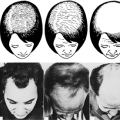OVERVIEW OF THE HYPOTHALAMUS
The human hypothalamus is a tiny wedged-shaped mass of tissue, composed primarily of gray matter, that subserves widespread functions, ranging from those considered somewhat automatic (i.e., autonomic) to more complex behaviors requiring a high level of integration. The hypothalamus is situated in the ventralmost diencephalon (Fig. 8-1). It is bounded laterally by portions of the subthalamus; medially by the vertically oriented, slitlike third ventricle; rostrally by the lamina terminalis; caudally by the mesencephalon; and dorsally by the thalamus. Ventrally, the hypothalamus is contiguous with the infundibulum and pituitary stalk; the latter serves to transmit axons en route to the neurohypophysis. On the ventral surface of the brain, the hypothalamus appears as a prominent set of protuberances, the paired mammillary bodies caudally, and the midline infundibular eminence. The boundaries of the hypothalamus are easily identified by the optic chiasm rostrally and by the caudal edge of the mammillary bodies as they are situated at the rostral limit of the interpeduncular fossa. Here, the caudal limits of the hypothalamus merge with the midbrain.
Stay updated, free articles. Join our Telegram channel

Full access? Get Clinical Tree





